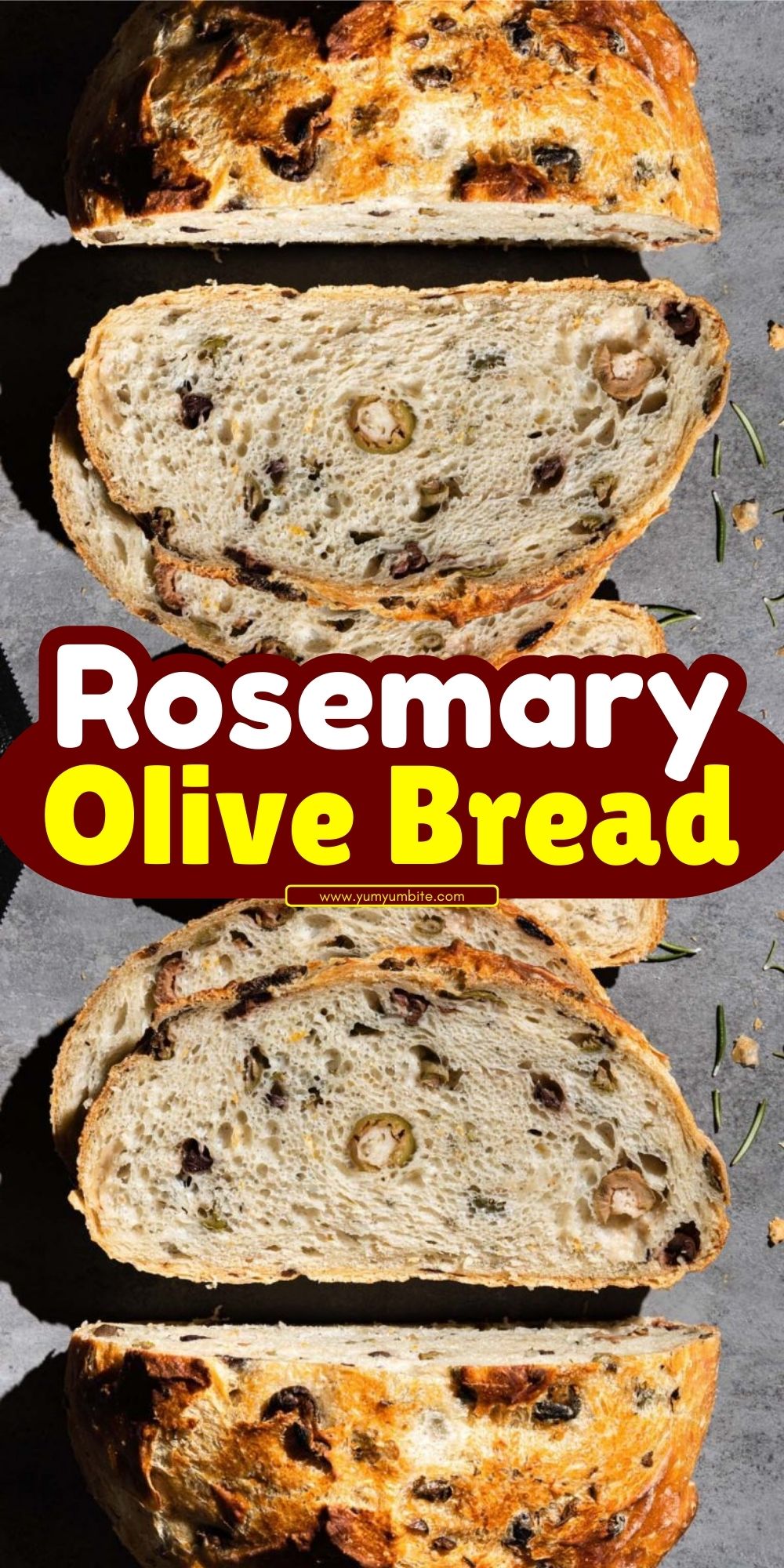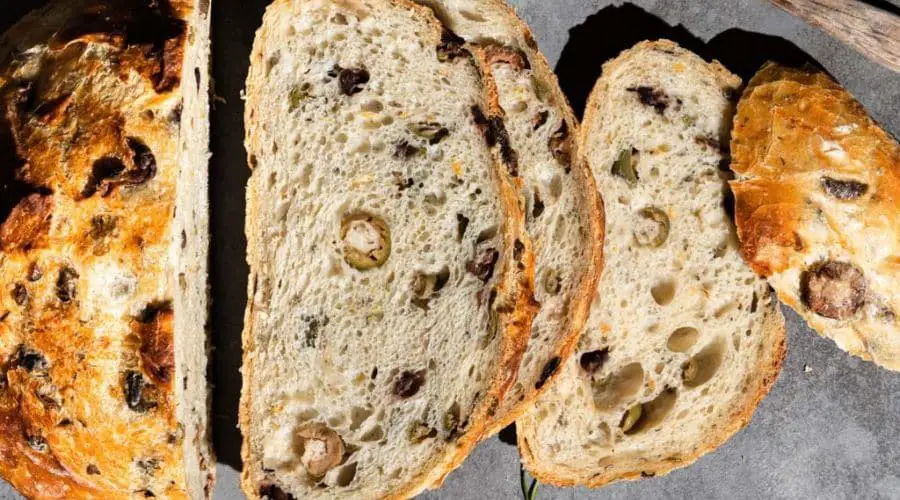There’s something truly special about the aroma of freshly baked Rosemary Olive Bread wafting through the kitchen.
This rustic, artisan-style loaf combines the earthiness of fresh rosemary with the briny depth of olives, creating a flavorful and textured bread that pairs beautifully with soups, cheeses, or simply a drizzle of olive oil.
Baked to golden perfection, it has a crisp, crackly crust and a soft, chewy crumb.
Whether you’re an experienced baker or a beginner, this recipe is easy to follow and guarantees bakery-quality results at home.

Why You’ll Love This Recipe
Aromatic & Flavorful
The combination of fresh rosemary and olives gives this bread a robust and savory taste, making every bite incredibly satisfying.
No Kneading Required
This is a no-knead bread, meaning you don’t need to spend time working the dough. A slow rise helps develop the flavor effortlessly.
Crispy Crust, Soft Inside
Baking in a Dutch oven creates the perfect texture—crispy on the outside, soft and airy on the inside.
Pairs Well with Everything
This bread is versatile! Enjoy it with a warm bowl of soup, alongside a cheese platter, or toasted with butter and honey.
Ingredients Needed
For the Dough:
- 3 ½ cups (440g) bread flour – Provides structure and chewiness.
- 1 ½ teaspoons salt – Enhances the flavors of the bread.
- 2 teaspoons instant yeast – Helps the dough rise quickly and evenly.
- 1 ⅓ cups (320ml) warm water – Activates the yeast and hydrates the flour.
- 2 tablespoons olive oil – Adds moisture and richness.
- ½ cup pitted olives, chopped – Use black or green olives for a briny depth.
- 1 tablespoon fresh rosemary, chopped – Infuses the bread with a fragrant, earthy aroma.
For Topping (Optional):
- Extra rosemary – Adds a burst of herbal flavor.
- Sea salt flakes – Enhances the crust’s texture and taste.
- Olive oil drizzle – Gives the crust a beautiful golden sheen.
Step-by-Step Instructions

Step 1: Mix the Dough
In a large mixing bowl, whisk together the bread flour, salt, and yeast. Pour in the warm water and olive oil, stirring with a wooden spoon or spatula until a sticky dough forms.
Fold in the chopped olives and fresh rosemary, ensuring they are evenly distributed.
Step 2: First Rise
Cover the bowl with plastic wrap or a clean towel and let the dough rise at room temperature for 1 to 2 hours, or until it has doubled in size.
Step 3: Shape the Dough
Lightly flour a work surface and gently turn out the dough. Using floured hands, shape it into a round loaf by folding the edges toward the center. Let it rest for 15-20 minutes while you preheat the oven.
Step 4: Preheat the Oven & Dutch Oven
Preheat your oven to 450°F (230°C). Place a Dutch oven (with its lid) inside to heat for 30 minutes.
Step 5: Bake the Bread
Carefully transfer the dough onto a piece of parchment paper. Remove the hot Dutch oven from the oven, place the dough inside, cover with the lid, and bake for 30 minutes.
Then, remove the lid and bake for another 10-15 minutes until the crust is deep golden brown.
Step 6: Cool & Serve
Transfer the bread to a wire rack and allow it to cool for at least 20 minutes before slicing. Enjoy warm or toasted with butter, olive oil, or your favorite spreads!
Tips for Perfect Rosemary Olive Bread
Use Fresh Ingredients
Fresh rosemary and high-quality olives make a significant difference in flavor. Avoid dried rosemary if possible, as it lacks the same aromatic punch.
Measure Flour Correctly
Spoon flour into the measuring cup and level it off rather than scooping directly from the bag. This prevents using too much flour, which can make the bread dense.
Let the Dough Rise Properly
Allowing the dough to rise fully (until doubled in size) ensures a light and airy crumb. Rushing this step can lead to a dense loaf.
Preheat the Dutch Oven
A hot Dutch oven creates steam that results in a crispy crust. Make sure to heat it for at least 30 minutes before baking.
Cool Before Slicing
Resist the urge to slice into the bread immediately! Letting it cool for at least 20 minutes helps set the crumb and keeps the inside from becoming gummy.
How to Store & Reheat
Storing:
- Keep the bread at room temperature in an airtight container or wrapped in a clean kitchen towel for up to 3 days.
- For longer storage, wrap the loaf tightly in plastic wrap and store it in the freezer for up to 2 months.
Reheating:
- To refresh the crust, warm the bread in a 350°F (175°C) oven for 10-15 minutes.
- If reheating from frozen, let the bread thaw at room temperature before warming in the oven.
What to Serve with Rosemary Olive Bread
Dips & Spreads:
- Olive oil & balsamic vinegar – A simple yet flavorful pairing.
- Whipped herb butter – Enhances the bread’s savory notes.
- Garlic hummus – A creamy, garlicky complement.
Soups & Stews:
- Tomato basil soup – A comforting and rich option.
- Minestrone – The hearty vegetables and broth go well with this rustic bread.
- French onion soup – Perfect for soaking up the flavorful broth.
Cheese & Charcuterie Boards:
- Brie, feta, or aged cheddar – Complements the herbal and salty flavors.
- Cured meats like prosciutto or salami – Adds a savory contrast.
Conclusion
Rosemary Olive Bread is a rustic, flavorful loaf that’s both easy to make and incredibly versatile.
With its crispy crust, tender interior, and rich aroma, it’s a great addition to any meal.
Whether you serve it alongside soups, with a cheese platter, or simply toasted with butter, this homemade artisan bread will quickly become a favorite in your kitchen.
Try it today and enjoy bakery-quality bread at home!
Frequently Asked Questions
1. Can I use dried rosemary instead of fresh?
Yes, but fresh rosemary provides the best flavor. If using dried, reduce the amount to 1 teaspoon since dried herbs are more concentrated.
2. What type of olives work best?
You can use either black or green olives, but make sure they are pitted and drained well. Kalamata and Castelvetrano olives add great flavor.
3. Can I make this bread without a Dutch oven?
Yes! If you don’t have a Dutch oven, bake the bread on a preheated baking stone with a pan of hot water on the bottom rack to create steam.
4. How can I make this bread gluten-free?
Use a gluten-free bread flour blend designed for yeast baking. Note that the texture may be slightly different.
5. Can I let the dough rise overnight?
Absolutely! A slow, overnight rise in the refrigerator enhances the flavor. Let the dough sit at room temperature for 30 minutes before baking.

Rosemary Olive Bread
Equipment
- 1 large mixing bowl
- 1 wooden spoon or spatula
- 1 Measuring Cup Set
- 1 Measuring Spoon Set
- 1 Dutch oven (with lid, 5-6 qt)
- 1 Parchment Paper Sheet
- 1 wire cooling rack
Ingredients
For the Dough:
- 3 ½ cups 440g bread flour
- 1 ½ teaspoons salt
- 2 teaspoons instant yeast
- 1 ⅓ cups 320ml warm water (about 110°F/45°C)
- 2 tablespoons olive oil
- ½ cup pitted olives chopped (black or green)
- 1 tablespoon fresh rosemary chopped
For Topping (Optional):
- Extra rosemary sprigs
- Sea salt flakes
- Olive oil drizzle
Instructions
Step 1: Mix the Dough
- In a large mixing bowl, whisk together the bread flour, salt, and yeast.
- Add the warm water and olive oil, stirring with a wooden spoon or spatula until a sticky dough forms.
- Fold in the chopped olives and fresh rosemary, ensuring even distribution.
Step 2: First Rise
- Cover the bowl with plastic wrap or a clean towel.
- Let the dough rise at room temperature for 1 to 2 hours, or until doubled in size.
Step 3: Shape the Dough
- Lightly flour a work surface and gently turn out the dough.
- Using floured hands, shape it into a round loaf by folding the edges toward the center.
- Let it rest for 15-20 minutes while preheating the oven.
Step 4: Preheat the Oven & Dutch Oven
- Preheat the oven to 450°F (230°C).
- Place a Dutch oven (with its lid) inside the oven and heat for 30 minutes.
Step 5: Bake the Bread
- Carefully transfer the dough onto a piece of parchment paper.
- Remove the hot Dutch oven from the oven, place the dough inside, cover with the lid, and bake for 30 minutes.
- Remove the lid and bake for another 10-15 minutes until the crust is deep golden brown.
Step 6: Cool & Serve
- Transfer the bread to a wire rack and allow it to cool for at least 20 minutes before slicing.
- Enjoy warm or toasted with butter, olive oil, or your favorite spreads!
Notes
- For a stronger rosemary flavor, add an extra teaspoon of chopped rosemary to the dough.
- For a crunchier crust, let the bread cool in the oven with the door slightly open for 10 minutes after baking.
- You can replace part of the flour (½ cup) with whole wheat flour for a nuttier flavor.
- If using active dry yeast instead of instant yeast, dissolve it in the warm water with a pinch of sugar before adding it to the flour.
- For a longer fermentation, let the dough rise in the refrigerator overnight for enhanced flavor.


